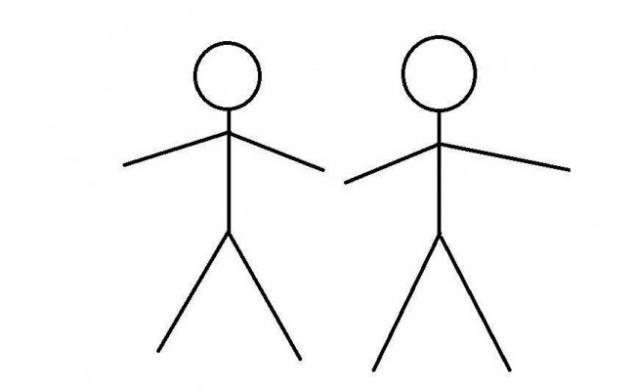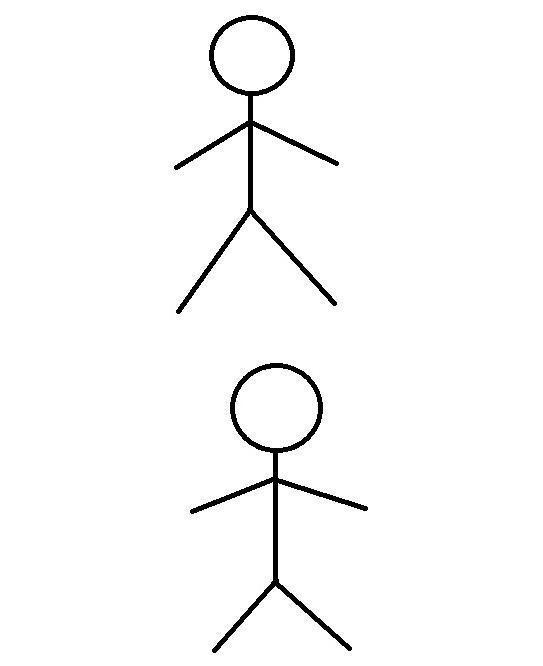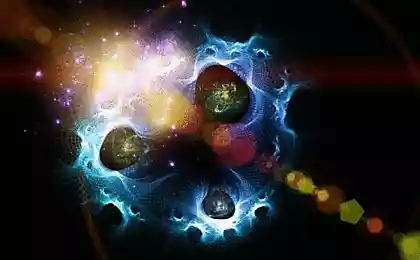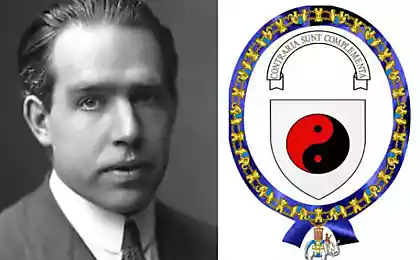653
10 dimensions of reality: simple and clear information about string theory
Consider from three to ten the biggest problem with theoretical physicists to unite all fundamental interactions (gravitational, electromagnetic, weak and strong) into one theory. Superstring theory just claims to be a theory of everything.
But it turned out that the most convenient number of dimensions for the theory — ten (nine of which are spatial and one time)! If measuring more or less the mathematical equations giving irrational results, stretching to infinity — a singularity.
The next stage in the development of superstring theory, M — theory has counted eleven dimensions. And another option — F-theory — all twelve. This is not a complication. F-theory describes the 12-dimensional space more simple equations than the M-theory is 11-dimensional.

Of course, theoretical physics is often called the theoretical. All its achievements there are still only on paper. To explain why we can only move in three-dimensional space, scientists started talking about how miserable the rest of the measurements had to shrink into a compact sphere at the quantum level. To be precise, it is not in the scope and space of the Calabi-Yau. These are three-dimensional figures, within which its own world with its own dimensions. Two-dimensional projection of these manifolds looks like this:

Such figures known more than 470 million. Which of them corresponds to our reality in the moment is calculated. It's not easy to be a theoretical physicist.
Yes, it seems a little far-fetched. But maybe this explains why the quantum world is so different from what we perceive.
Dot, dot, comma, let's Start from the beginning. The zero dimension is a point. It has no size. Nowhere to go, no origin to indicate the location in this dimension is not necessary.
Put next to the first point of the second and draw through them the line. Here you have the first measurement. From a one-dimensional object is the size — length, but neither breadth nor depth. Movement within one-dimensional space is very limited, because of the arisen obstacle to bypass. To locate on this segment, it will take only one coordinate.
Put near the cut point. To fit both of these objects, we will need a two-dimensional space having length and width, i.e., area, but without depth, that is, volume. The location of any point on this field is determined by two coordinates.
The third dimension arises when we add to this system the third axis of coordinates. We, the residents of the three-dimensional universe, it is very easy to imagine it.
Try to imagine how you see the world the inhabitants of the two-dimensional space. For example, these two man:

Each of them will see his friend like this:

And if that's this scenario:

Our heroes see each other:

The change of viewpoint allows our heroes to judge each other as two-dimensional objects, not one-dimensional segments.
Now imagine that a volumetric object is moving in the third dimension, which intersects this two-dimensional world. To the casual observer, this movement is expressed in the change of two-dimensional projections of the object on the plane, as the broccoli in an MRI machine:

But for the occupant of our flatland this picture is unfathomable! He is unable even to imagine it. For him, each of two-dimensional projections will see a one-dimensional segment with a mysteriously changeable length, emerging in unpredictable places and unpredictable endangered. Attempts to calculate the length and place of occurrence of such objects using the laws of physics of two-dimensional space, doomed to failure.
We, the inhabitants of the three-dimensional world, we see everything two-dimensional. Only moving object in space allows us to feel its volume. Any multi-dimensional object, we see also two-dimensional, but it will be an amazing way to change depending on our location or time.
From this point of view it is interesting to think about, for example, gravity. All probably seen these pictures:

Taken to represent them, how gravity bends space-time. Bends... where? Exactly the same familiar measurements. And quantum tunneling, that is, the ability of a particle to disappear in one place and appear in another, and a barrier through which our reality is she would be unable to penetrate, not having done a hole in it? And black holes? What if all these and other riddles of modern science due to the fact that the geometry of space is not like what we used to perceive it?
Ticking clock Time adds to our Universe another coordinate. In order that the party be held, you need to know not only what bar it happens, but the exact time of this event.
Based on our perception, time is not so much straight as a beam. That is, it is a starting point, and the movement is only in one direction — from past to future. And really only the present. Neither the past nor the future exist as not exist breakfasts and dinners from the point of view of an office clerk during the lunch break.
But the theory of relativity disagrees. From her point of view, time is a dimension. All events that have existed, exist and will exist, are equally real as the real beach, no matter where it dreams about the sound of the waves caught us off-guard. Our perception is just something like a floodlight that illuminates on the time line a period. Humanity in its fourth dimension looks like this:

But we see only the projection, the slice of that dimension in each individual time. Yes, as the broccoli in an MRI machine.
Until now, all the theory worked with a large number of spatial dimensions and a time has always been the only one. But why the space admits the appearance of multiple dimensions to space, but only one? While scientists can't answer this question, the hypothesis of two or more temporary spaces will seem very attractive to all philosophers and science fiction. Yes, and physicists, which is already there. For example, the American astrophysicist Itzhak bars the root of all the troubles with the Theory of everything sees just overlooked the second temporal dimension. As a mental exercise, try to imagine a world with two times.
Each dimension is separate. This is reflected in the fact that if we change the coordinates of the object in one dimension, the coordinates in the other can remain unchanged. So, if you move on one axis which crosses the other at right angles, the intersection being around will stop. In practice it will look something like this:

All Neo had to do is to place their one-dimensional temporal axis perpendicular to the time axis of the bullets. A mere trifle, agree. It is actually much more complicated.
The exact time in the universe with two time dimensions will be determined by two values. Weakly imagine a two-dimensional event? That is, such which extended simultaneously at two time axes? It is likely that in such a world will need specialists in mapping time how cartographers make maps, two-dimensional surface of the globe.
What else makes a two-dimensional space from a one-dimensional? The ability to bypass an obstacle, for example. It is quite beyond the borders of our mind. A resident of a one-dimensional world can imagine what it's like to turn a corner. Yes, and that is the corner in time? In addition, in two-dimensional space, you can travel forward, backward, Yes, even diagonally. I have no idea how it is to go through time diagonally. I'm not talking about what time is the basis of many physical laws, and how to change the physics of the Universe with the appearance of another temporal dimension, it is impossible to imagine. But thinking about it is so exciting!
A very big encyclopedia Other dimensions are not open yet, and only exist in mathematical models. But you can try to imagine it like this.
As we found earlier, we see three-dimensional projection of the fourth (temporal) dimension of the Universe. In other words, every moment of existence in our world is a point (similar to the zero measure) in the time interval from the Big Bang to the end of the world.
Those of you who have read about time travel, you know what an important role is played by the curvature of space-time continuum. This is the fifth dimension in it "bends" four-dimensional space-time to bring together some two points on this line. Without this, the journey between these points would be too lengthy, or impossible. Roughly speaking, the fifth dimension is similar to the second, it moves the "one-dimensional" line of time-space "two-dimensional" plane with all the consequences of being able to turn the corner.
Our very philosophical-minded readers a little earlier might be wondering about the possibility of free will in terms of where the future already exists, but it is not yet known. Science answers this question: probability. The future is not a stick, and a broom of the possible scenarios. Some of them will come true — find out when we get there.
Every probability exists in the form of "one-dimensional" cut "plane" of the fifth dimension. What is the fastest way to jump from one segment to another? That's right — bend the plane like a sheet of paper. Where to bend? Right again — in the sixth dimension, which gives the whole complex structure "volume". And, thus, makes it like a three-dimensional space, "finished", new point.
Seventh dimension is a new video, which consists of six-dimensional points. What represents any other point on this line? The entire infinite set of variants of development of events in the other universe, formed not as a result of the Big Bang, and in different conditions and acting according to other laws. That is, seventh dimension — the beads of parallel worlds. The eighth dimension collects these "direct" in one "plane". And the ninth can be compared with the book, which could fit all the "leaves" of the eighth dimension. This is the sum of all stories of all universes with all laws of physics and all initial conditions. Again dot.
Then we run into the limit. To imagine the tenth dimension, we need video. And what could be another point on this line, if the ninth dimension already covers everything you can imagine and even that impossible to imagine? It turns out, the ninth dimension is not just another starting point, and the final is for our imagination, anyway.
String theory says that in the tenth dimension make their vibrations of a string — the basic particles that comprise all. If the tenth dimension contains all universes and all opportunities, strings are everywhere, all the time. I mean, each string exists in our universe and any other. At any point in time. Immediately. Cool, huh? published
P. S. And remember, only by changing their consumption — together we change the world! ©
Source: revolverlab.com/10-izmereniy-realnosti-prosto-i-ponyatno-o-teorii-strun/
But it turned out that the most convenient number of dimensions for the theory — ten (nine of which are spatial and one time)! If measuring more or less the mathematical equations giving irrational results, stretching to infinity — a singularity.
The next stage in the development of superstring theory, M — theory has counted eleven dimensions. And another option — F-theory — all twelve. This is not a complication. F-theory describes the 12-dimensional space more simple equations than the M-theory is 11-dimensional.

Of course, theoretical physics is often called the theoretical. All its achievements there are still only on paper. To explain why we can only move in three-dimensional space, scientists started talking about how miserable the rest of the measurements had to shrink into a compact sphere at the quantum level. To be precise, it is not in the scope and space of the Calabi-Yau. These are three-dimensional figures, within which its own world with its own dimensions. Two-dimensional projection of these manifolds looks like this:

Such figures known more than 470 million. Which of them corresponds to our reality in the moment is calculated. It's not easy to be a theoretical physicist.
Yes, it seems a little far-fetched. But maybe this explains why the quantum world is so different from what we perceive.
Dot, dot, comma, let's Start from the beginning. The zero dimension is a point. It has no size. Nowhere to go, no origin to indicate the location in this dimension is not necessary.
Put next to the first point of the second and draw through them the line. Here you have the first measurement. From a one-dimensional object is the size — length, but neither breadth nor depth. Movement within one-dimensional space is very limited, because of the arisen obstacle to bypass. To locate on this segment, it will take only one coordinate.
Put near the cut point. To fit both of these objects, we will need a two-dimensional space having length and width, i.e., area, but without depth, that is, volume. The location of any point on this field is determined by two coordinates.
The third dimension arises when we add to this system the third axis of coordinates. We, the residents of the three-dimensional universe, it is very easy to imagine it.
Try to imagine how you see the world the inhabitants of the two-dimensional space. For example, these two man:

Each of them will see his friend like this:

And if that's this scenario:

Our heroes see each other:

The change of viewpoint allows our heroes to judge each other as two-dimensional objects, not one-dimensional segments.
Now imagine that a volumetric object is moving in the third dimension, which intersects this two-dimensional world. To the casual observer, this movement is expressed in the change of two-dimensional projections of the object on the plane, as the broccoli in an MRI machine:

But for the occupant of our flatland this picture is unfathomable! He is unable even to imagine it. For him, each of two-dimensional projections will see a one-dimensional segment with a mysteriously changeable length, emerging in unpredictable places and unpredictable endangered. Attempts to calculate the length and place of occurrence of such objects using the laws of physics of two-dimensional space, doomed to failure.
We, the inhabitants of the three-dimensional world, we see everything two-dimensional. Only moving object in space allows us to feel its volume. Any multi-dimensional object, we see also two-dimensional, but it will be an amazing way to change depending on our location or time.
From this point of view it is interesting to think about, for example, gravity. All probably seen these pictures:

Taken to represent them, how gravity bends space-time. Bends... where? Exactly the same familiar measurements. And quantum tunneling, that is, the ability of a particle to disappear in one place and appear in another, and a barrier through which our reality is she would be unable to penetrate, not having done a hole in it? And black holes? What if all these and other riddles of modern science due to the fact that the geometry of space is not like what we used to perceive it?
Ticking clock Time adds to our Universe another coordinate. In order that the party be held, you need to know not only what bar it happens, but the exact time of this event.
Based on our perception, time is not so much straight as a beam. That is, it is a starting point, and the movement is only in one direction — from past to future. And really only the present. Neither the past nor the future exist as not exist breakfasts and dinners from the point of view of an office clerk during the lunch break.
But the theory of relativity disagrees. From her point of view, time is a dimension. All events that have existed, exist and will exist, are equally real as the real beach, no matter where it dreams about the sound of the waves caught us off-guard. Our perception is just something like a floodlight that illuminates on the time line a period. Humanity in its fourth dimension looks like this:

But we see only the projection, the slice of that dimension in each individual time. Yes, as the broccoli in an MRI machine.
Until now, all the theory worked with a large number of spatial dimensions and a time has always been the only one. But why the space admits the appearance of multiple dimensions to space, but only one? While scientists can't answer this question, the hypothesis of two or more temporary spaces will seem very attractive to all philosophers and science fiction. Yes, and physicists, which is already there. For example, the American astrophysicist Itzhak bars the root of all the troubles with the Theory of everything sees just overlooked the second temporal dimension. As a mental exercise, try to imagine a world with two times.
Each dimension is separate. This is reflected in the fact that if we change the coordinates of the object in one dimension, the coordinates in the other can remain unchanged. So, if you move on one axis which crosses the other at right angles, the intersection being around will stop. In practice it will look something like this:

All Neo had to do is to place their one-dimensional temporal axis perpendicular to the time axis of the bullets. A mere trifle, agree. It is actually much more complicated.
The exact time in the universe with two time dimensions will be determined by two values. Weakly imagine a two-dimensional event? That is, such which extended simultaneously at two time axes? It is likely that in such a world will need specialists in mapping time how cartographers make maps, two-dimensional surface of the globe.
What else makes a two-dimensional space from a one-dimensional? The ability to bypass an obstacle, for example. It is quite beyond the borders of our mind. A resident of a one-dimensional world can imagine what it's like to turn a corner. Yes, and that is the corner in time? In addition, in two-dimensional space, you can travel forward, backward, Yes, even diagonally. I have no idea how it is to go through time diagonally. I'm not talking about what time is the basis of many physical laws, and how to change the physics of the Universe with the appearance of another temporal dimension, it is impossible to imagine. But thinking about it is so exciting!
A very big encyclopedia Other dimensions are not open yet, and only exist in mathematical models. But you can try to imagine it like this.
As we found earlier, we see three-dimensional projection of the fourth (temporal) dimension of the Universe. In other words, every moment of existence in our world is a point (similar to the zero measure) in the time interval from the Big Bang to the end of the world.
Those of you who have read about time travel, you know what an important role is played by the curvature of space-time continuum. This is the fifth dimension in it "bends" four-dimensional space-time to bring together some two points on this line. Without this, the journey between these points would be too lengthy, or impossible. Roughly speaking, the fifth dimension is similar to the second, it moves the "one-dimensional" line of time-space "two-dimensional" plane with all the consequences of being able to turn the corner.
Our very philosophical-minded readers a little earlier might be wondering about the possibility of free will in terms of where the future already exists, but it is not yet known. Science answers this question: probability. The future is not a stick, and a broom of the possible scenarios. Some of them will come true — find out when we get there.
Every probability exists in the form of "one-dimensional" cut "plane" of the fifth dimension. What is the fastest way to jump from one segment to another? That's right — bend the plane like a sheet of paper. Where to bend? Right again — in the sixth dimension, which gives the whole complex structure "volume". And, thus, makes it like a three-dimensional space, "finished", new point.
Seventh dimension is a new video, which consists of six-dimensional points. What represents any other point on this line? The entire infinite set of variants of development of events in the other universe, formed not as a result of the Big Bang, and in different conditions and acting according to other laws. That is, seventh dimension — the beads of parallel worlds. The eighth dimension collects these "direct" in one "plane". And the ninth can be compared with the book, which could fit all the "leaves" of the eighth dimension. This is the sum of all stories of all universes with all laws of physics and all initial conditions. Again dot.
Then we run into the limit. To imagine the tenth dimension, we need video. And what could be another point on this line, if the ninth dimension already covers everything you can imagine and even that impossible to imagine? It turns out, the ninth dimension is not just another starting point, and the final is for our imagination, anyway.
String theory says that in the tenth dimension make their vibrations of a string — the basic particles that comprise all. If the tenth dimension contains all universes and all opportunities, strings are everywhere, all the time. I mean, each string exists in our universe and any other. At any point in time. Immediately. Cool, huh? published
P. S. And remember, only by changing their consumption — together we change the world! ©
Source: revolverlab.com/10-izmereniy-realnosti-prosto-i-ponyatno-o-teorii-strun/
The 3 most dreaded words — duty, duty, responsibility
Unusual Cardok garage is an ideal solution for small area























